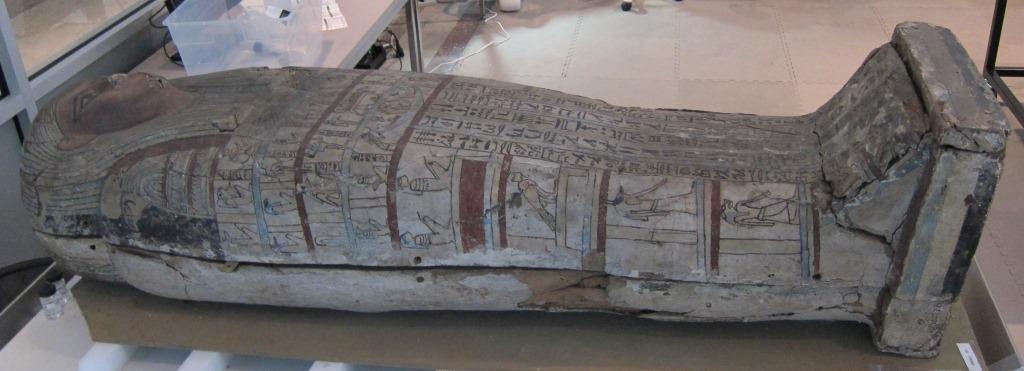Molly Gleeson, the primary project conservator for the Artifact Lab is on vacation so, if you come by over the next little while, one of the other staff conservators (Julie Lawson, Nina Owczarek and I – Lynn Grant) will be taking turns being the Conservator on Duty. While there, we work on the same sorts of projects that Molly does but you might wonder what we do when it’s not our turn in the fishbowl. With a collection of over a million artifacts, there’s plenty to keep three (or even 30, if we just had room) busy. Because Penn Museum’s collections are so large, we have to prioritize what we work on. The conservation treatments we’re working on right now are mostly for objects going on exhibition (mainly Native American artifacts for an exhibition opening in a year), or on loan (we loan artifacts to Museums all over the world; this fall we’ve worked on objects going to New York, Indianapolis, Cleveland, Spain, Amsterdam, Switzerland, and Taiwan, to name just a few) or artifacts being photographed for publication.

One of the places conservator Lynn Grant spent time recently: an art storage warehouse in Connecticut where some of our collections were stored (white crates).
In addition, we work very closely with other Museum staff on preventative conservation (see Molly’s earlier
blog post, to keep our collections in the best possible condition. This means monitoring storage conditions, artifacts on exhibition, advising on materials used in display, and many other tasks. These don’t always happen in the Museum, either. We conservators often act as couriers, accompanying artifacts as they travel to make sure that they receive the proper care. One recent courier trip I did has a certain amount of overlap with work in the Artifact lab, since it involved an Ancient Egyptian tomb chapel.

One block (the false door) from the offering chapel of Kapure. This single limestone block weighs over 9000 pounds.
The late Old Kingdom
offering chapel of Kapure from Saqqara (dating to ca. 2300 B.C.) was once part of this high ranking official’s mudbrick mastaba tomb. The interior of the chapel was lined with limestone blocks beautifully decorated with carved and painted scenes representing the deceased seated at a table of offerings and receiving funerary provisions. Part of the chapel of Kapure is on display in the Museum’s Lower Egyptian Gallery. The rest, which was part of a traveling exhibition in the late 1990s, has been in storage in Connecticut since 2000. This was supposed to be a temporary situation but it’s gone on for longer than we ever expected and now that there is a suitable storage facility here in Philadelphia, we decided to bring the tomb chapel closer to home. Why wouldn’t we just bring it back to the Museum, you ask? Well, it’s kind of big and very unwieldy. There were 8 crates, the heaviest of which weighed over
9000 lbs. We hope to be able to reinstall it in our Egyptian Galleries before too much longer but until then, it will stay in specialized art storage.

My colleagues in adventure, Bob Thurlow (left) and Jen Wegner, get ready to to work on our crated limestone blocks.
Getting it there was a bit of an adventure. Three Museum staff members: Bob Thurlow of the Registrar’s Office, Dr. Jen Wegner of the Egyptian Section, and myself, traveled to the warehouse where it was stored in Connecticut. There we had to open each crate; document the current condition of the blocks inside both with digital photography and written descriptions; check that the crates were still in good enough condition to protect the artifacts during transit; make any necessary improvements to the crates; then oversee the loading of the crates on to a very large truck; follow the truck to the new warehouse; and finally supervise the unloading and placement of the crates there. This all took two-and-a-half days and meant long hours working in an unheated warehouse – in November.

Art handlers and warehouse men load the false door crate on to the truck, using the big forklift (the smaller one couldn’t lift the 9000 lb weight). The crate fit with about 2 inches to spare – a tribute to Bob Thurlow’s excellent planning and preparation.

Jen Wegner explaining the finer points of the false door block to two of the warehouse employees just before we put the lid back on and prepared to take it back to Philadelphia.
This is not the glamorous part of our jobs! Still, it needed to be done and it was a great chance to get up close and personal with some gorgeous Egyptian funerary art. Working with Jen Wegner was a treat as she was able to tell us what we were looking at and read the inscriptions. I’m sure Jen got tired of me asking what various symbols were, especially since most of them seemed to be bread – apparently Egyptian funerals were a carb-fest!
posted by Lynn Grant











